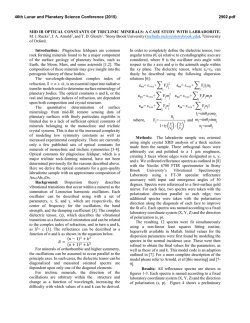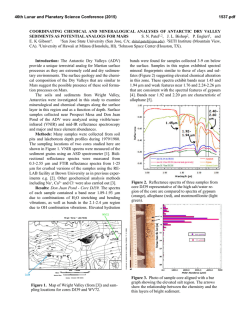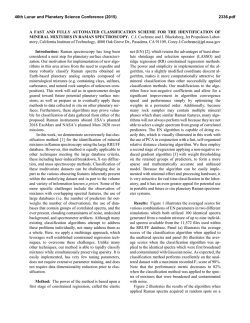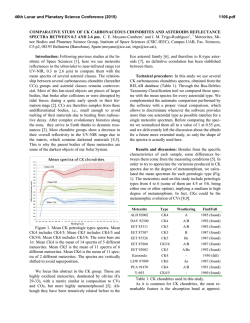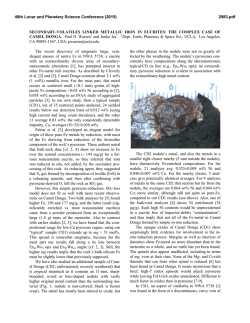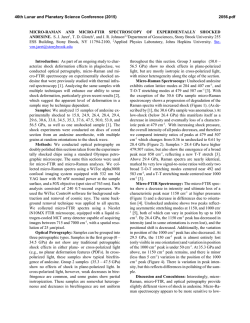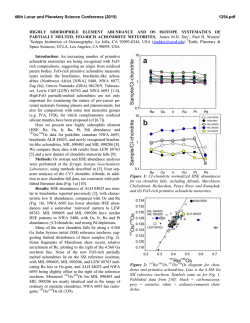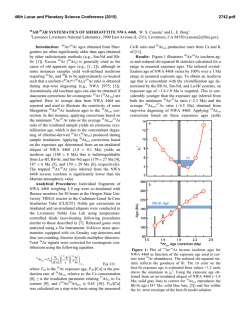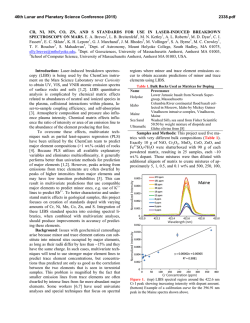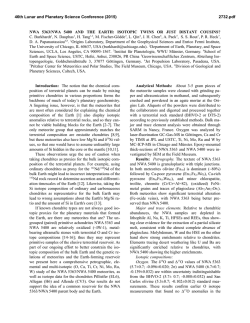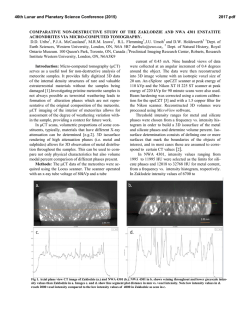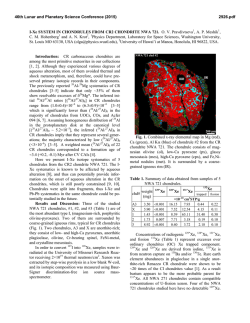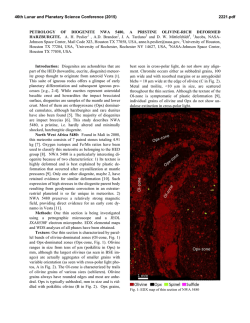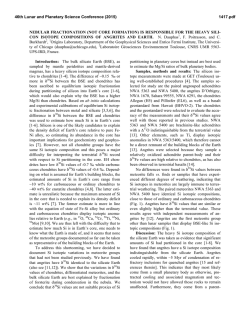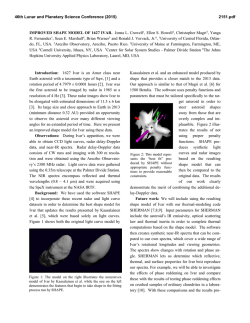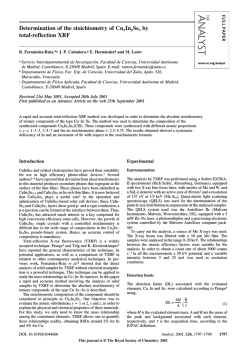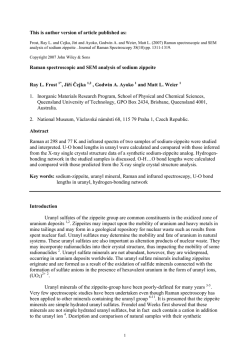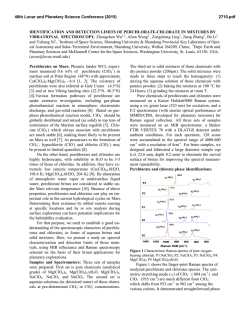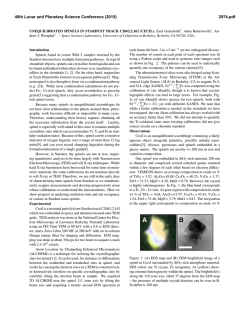
Crystallinity and Preferred Orientation of Phases in Gabbroic
46th Lunar and Planetary Science Conference (2015) 2712.pdf CRYSTALLINITY AND PREFERRED ORIENTATION OF PHASES IN GABBROIC SHERGOTTITE NWA 6963. V. E. Hamilton1 and J. Filiberto1, 1Southwest Research Institute, 1050 Walnut St. #300, Boulder, CO 80302 USA ([email protected]); 2Department of Geology, Southern Illinois University, 1259 Lincoln Drive, MC 4324, Carbondale, IL 62901 USA. Introduction: Northwest Africa 6963 (NWA 6963) is a basaltic Shergottite notable for having a gabbroic texture (Figure 1), pyroxene with strong shape-preferred orientation, and quartz-alkali feldspar intergrowths (with graphic texture) that are inferred to represent a late-stage granitic melt [1, 2]. We are investigating the crystallinity and orientation of phases in NWA 6963 using FTIR micro-spectroscopy to better understand the processes that have influenced or affected this rock. Pyroxene spectra exhibit crystallographic orientation effects, and we are in the process of determining whether there is a preferred orientation. The spectra of the graphic intergrowths reveal them to be amorphous, indicating that they were additionally processed after crystallization. We find that maskelynite shows no residual crystalline features, constraining shock pressure. Figure 1. Optical microscope image of NWA 6963 sample analyzed in this study. Image by A. Wittman (Wash. U.). Data and Methods: We measured thermal infrared (TIR) spectra of a thick section of NWA 6963 using a ThermoElectron iN10 FTIR reflectance microscope in the spectroscopy laboratory at SwRI-Boulder. Analyzing a thick section minimizes the likelihood of internal reflections, and none were observed. Unlike traditional bulk reflection or emission spectroscopy, this technique allows for the in situ investigation of the spectral character of individual grains in the sample, enabling a more accurate assessment of phase abundance, crystallinity, and orientation. This iN10 microscope is capable of measuring spectra from 12,500 to 400 cm-1 (~0.8 – 25 µm) at spot sizes ranging from 10 - 300 µm (the diffraction limit sets in at ~25 µm in the TIR). An automated stage permits mapping of flat sample surfaces with selectable spatial resolution. We mapped ~6.6 mm2 of NWA 6963 at 300 µm spatial resolution (506 spectra) over the spectral range 5000 – 400 cm-1 (2 – 25 µm). Follow-on point analyses targeting specific phases were measured with ~25 – 50 µm spot sizes. A fracture in the sample is filled with epoxy; however, the distinctive TIR spec- trum of epoxy allows us to identify spectra contaminated by this component and subtract its contribution. Figure 2. Map, average, and standard deviation spectra for NWA 6963. Arrows indicate carbonate (left) and oxide/sulfide (right) features. FTIR Map Spectra: All 506 map spectra are shown (E=1-R) in Figure 2, along with the average and standard deviation. The average spectrum of this particular slice of NWA 6963 is in family with the TIR spectra of other Shergottites (Figure 3). However, there are features present in the individual map spectra that are not apparent in the average spectrum, such as a minimum at ~1407 cm-1 (carbonate) and a strong absorption from ~680 – 400 cm-1 (oxide and/or sulfide). These phases are not sufficiently abundant in total for their features to appear in the average spectrum. Addi- Figure 3. Average NWA 6963 spectrum compared to basaltic Shergottites Zagami, EET A79001, and Los Angeles. 46th Lunar and Planetary Science Conference (2015) tional phases that are identified in the map spectra include: pigeonite, augite, maskelynite, a silicic amorphous phase, and apatite. Olivine is not present in this sample, although fayalitic olivine is known to be present in the meteorite at minor abundances [1]. Pyroxene. Pigeonite and augite in NWA 6963 exhibit shape preferred orientation [1]. Their TIR spectra exhibit crystallographic orientation effects, as expected in cases where the analytical spot size is smaller than the crystal size. By identifying the orientations of each grain via its TIR spectrum [e.g., 3], we are mapping the grains’ orientations and will determine whether there is a fabric of preferred crystallographic orientation. Maskelynite. Maskelynite in NWA 6963 (An36-55) [4] exhibits no residual crystalline features in the 675 400 cm-1 range (Figure 4), unlike the Manicouagan maskelynite (MM, An50) used by [5, 6] for modeling of Martian meteorite spectra. The Si-O stretching mode absorption (minimum) in NWA 6963 is at 1020 cm-1 vs. 998 cm-1 in MM, consistent with its relatively more silica-rich (more albitic) composition. By comparison with spectra of increasingly shocked anorthosite chips [7, not shown], we infer that NWA 6963 experienced shock pressures >~38 GPa, consistent with the pyroxene deformation fabric analysis observed by [4]. Figure 4. Terrestrial maskelynite from the Manicouagan impact crater shows residual crystalline features (arrows) that are not present in NWA 6963 maskelynite, constraining meteorite shock pressures to >~38 GPa. Graphic intergrowths having chemical compositions of quartz and K-spar are amorphous and not as chemically pure as SiO2 or alkali glasses [8]. Graphic intergrowths. Although the individual components of the quartz-alkali feldspar intergrowths are smaller than our measurement spot size, many of the intergrowths are not. If the intergrowth phases are crystalline, their spectra should be the linear sum of crystalline quartz and alkali feldspar spectra. However, the spectra indicate that these phases are amorphous because they exhibit classical amorphous shapes [e.g., 2712.pdf 8] with no quartz or feldspar absorptions present. The wavenumber position of the Si-O stretching mode absorption (vertical line, Figure 4) indicates that these intergrowths are more silicic than maskelynite. Specifically, the minimum is at 1097 cm-1, between those of SiO2 glass and obsidian/interstitial alkali glass [8]. Additionally, this band is wider in the meteorite phase, suggesting a composition with a broader cation compositional range [9], consistent with the presence of a mixed quartz/alkali feldspar chemistry. In thin section, the intergrowths are brown and mostly go extinct, although there are micron-sized grains with high birefringence present. Shock is likely to be responsible for the observed optical and spectral character. Carbonate. Fifteen spectra in our map (representing at least six discrete locations) display identical features attributable to carbonate. The fact that the spectra do not exhibit crystallographic orientation effects leads us to consider two hypotheses for their physical character: 1) the carbonates all share the same optic axis orientation, or 2) each occurrence is composed of numerous, randomly-oriented grains smaller than our 300 µm spot size. The former seems unlikely. The latter could be a result of precipitation of small calcite grains, or possibly shock, where shock-melted carbonate may recrystallize. Because some carbonates occur adjacent to a large crack in the sample and because carbonates have not been identified in any Shergottites to date, we infer that these are a terrestrial alteration product. Apatite and Oxide/Sulfide. A few apatite and oxide and/or sulfide spectra are present in the NWA 6963 map. These phases exhibit evidence of crystallographic orientation, although there are not enough occurrences to distinguish any preferential alignment. Summary: The average TIR spectrum of NWA 6963 is in family with the spectra of other Shergottites. The spectral character of maskelynite allows us to constrain shock pressures to >~38 GPa and shows that graphic intergrowths are amorphous. We are currently evaluating whether or not pigeonite and augite are crystallographically oriented. References: [1] Filiberto, J. et al. (2014) Am. Min., 99, 601-606. [2] Gross, J. and Filiberto, J. (2014) LPSC, 45, Abstract #1440. [3] Arnold, J. A. et al. (2014) Am. Min., 99, 1942-1955. [4] Filiberto, J. et al. (2014) MaPS,49 (s1), Abstract #5064. [5] Hamilton, V. E. et al. (1997) JGR-P, 102, 25,593-25,603. [6] Hamilton, V. E. (2010) Chemie der Erde, 70, 7-33. [7] Johnson, J. R. et al. (2002) JGR-P, 107, doi: 10.1029/2001J001517. [8] Wyatt, M. B. et al. (2001), JGR-P, 106, 14,711-14,732. [9] Minitti, M. E. and Hamilton, V. E. (2010), Icarus, 210, 135-149.
© Copyright 2025
